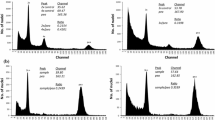Summary
On screening samples of seed of commercial kale for spontaneous haploids, unexpectedly large numbers of triploid seeds were found in the small seed fractions. These are presumed to have arisen from unreduced gametes and may be similar in origin to diploid maternals, more usually obtained via interspecific pollination.
Similar content being viewed by others
References
Catcheside, D. G., 1937. Secondary pairing in Brassica oleracea. Cytol. Fujii Jub. Vol.: 366–368.
Eenink, A. H., 1974. Matromorphy in Brassica oleracea L. Euphytica 23: 429–445.
Fukushima, E., 1931. Formation of diploid and tetraploid gametes in Brassica. Jap. J. Bot. 5: 273–283.
Harberd, D. J., 1972. A contribution to the cytotaxonomy of Brassica (Gruciferae) and its allies. Bot. J. Linn. Soc. 65: 1–23.
Hermsen, J. G. Th., M., Wagenvoort & M. S., Ramanna, 1970. Aneuploids from natural and colchicine-induced autotetraploids of Solanum. Can. J. Genet. Cytol. 12: 601–613.
Howard, H. W., 1939. The size of seeds in diploid and autotetraploid Brassica oleracea L. J. Genet. 38: 325–340.
Kimber, G. & R., Riley, 1963. Haploid Angiosperms. Bot. Rev. 29: 480–531.
Mackay, G. R., 1968. In: G. E. Dixon (Ed.), Possibilities from the use of matromorphy. Proc. Brassica Meet. of Eucarpia, September 1968.
Mackay, G. R., 1972. On the genetic status of maternals induced by pollination of Brassica oleracea L. with Brassica campestris L. Euphytica 21: 71–77.
Noguchi, Y., 1928. Cytological studies on a case of pseudogamy in the genus Brassica. Proc. imp. Acad. Japan 4: 367–372.
Olsson, G. & A., Hagberg, 1955. Investigations on haploid rape. Hereditas Lund. 41: 227–237.
Palmer, T. P., 1962. Population structure, breeding system, interspecific hybridisation and allopolyploidy. Heredity 17: 278–284.
Röbbelen, G., 1966. Beobachtungen bei interspezifischen Brassica — Kreuzzungen, insbesondere über die Entstehung matromorpher F1-Pflanzen. Angew. Bot. 39 (6): 205–221.
Thompson, K. F., 1956. Production of haploid plants of marrow-stem kale. Nature Lond. 178: 748.
Tokumasu, S., 1965. On the origin of the matroclinous plants of B. japonica, obtained from the cross between Brassica and Raphanus. J. Jap. Soc. hort. Sci. 34: 223–231.
U. N., 1935. Genome analysis in Brassica with special reference to experimental formation of B. napus and peculiar mode of fertilisation. Jap. J. Bot. 7: 389–452.
Yarnell, S. H., 1956. Cytogenetics of the vegetable crops. II. Crucifers. Bot. Rev. 22: 81–166.
Author information
Authors and Affiliations
Rights and permissions
About this article
Cite this article
Mackay, G.R., Low, R.J. Spontaneous triploids in forage kale, Brassica oleracea var. acephala . Euphytica 24, 525–529 (1975). https://doi.org/10.1007/BF00028224
Received:
Issue Date:
DOI: https://doi.org/10.1007/BF00028224




